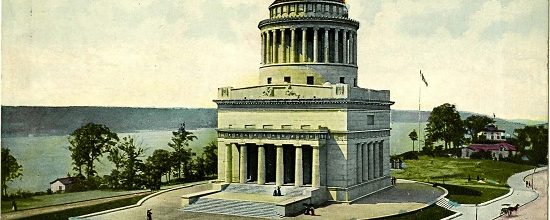Ulysses S. Grant: National Hero and Literary Extraordinaire

By E. V. |
The Grant Memorial Tomb, situated on the corner of Riverside Drive and W. 122nd Street in Manhattan, is the final resting place of President Ulysses S. Grant, who was in office from 1869-1877. Grant Memorial Tomb is a marble and granite building constructed with a dome at the top. The building has an eagle statue at each side of it, a symbol of American freedom. The coffins for Grant and his wife are situated in the center of the dome on the lower level of the mausoleum. The structure was adorned with different mosaics and statues that represent important phases in Grant’s life. Maps that outline each battle of the Civil War with tallied wins and losses decorate the walls. It is truly a treasure to visit this site because it is a significant part of American history. Being in the presence of what represents Grant’s life is beneficial in understanding what events helped build the America we know today.
The author’s video record of her visit to Grant’s Tomb
Grant wrote a series of personal memoirs towards the end of his life in order to leave his family a source of income. After his presidency, Grant had fallen victim to a Ponzi scheme which left him bankrupt. Due to this incident, he found himself in a position of need. Grant was very ill at the end of his life due to a throat cancer he developed from smoking tobacco, and one of the few ways for him to generate income for his family was through writing. It was very responsible of him to write these memoirs to not leave his family unprotected. The first volume of Grant’s Personal Memoirs covers his early life, his training, his involvement in the Mexican-American War, and the beginnings of the Civil War. The second volume addresses each battle he had charge of during the Civil War through to the end of the war. Due to Grant’s popularity during his time in office and his various accomplishments, the American people were devastated when he died. For this reason there was plenty of support to build his memorial after his passing.
The most fascinating part of the tomb’s interior is that each of the four corners of the dome represents a stage of Grant’s life recognizable from his memoirs. There is a depiction of his birth, military career, presidential career, and lastly his death. While reading the memoirs, you can align each depiction with its respective chapter. Grant speaks about his family history and birth in the first chapter of his memoirs, which are depicted in the first statue. He details his origins and his days as a young school boy. The corresponding statue shows a man and woman sitting by a tree. This image can be interpreted to symbolize his growth. The second statue shows two men holding onto the same sword with one hand and holding a helmet and shield with their other hands. These men symbolize Grant’s military career, which he writes about in chapter 2 of the memoirs. In this chapter, Grant reveals his different experiences at the West Point Military School. The rest of the chapters in the memoir detail the different battles he participated in with all his victories and losses. The third statue in the dome, which depicts two men sitting by a sharp weapon with one holding a large horn, represents his presidential career, which he does not discuss specifically in his memoirs. The final statue in the fourth corner of the dome symbolizes Grant’s death and depicts two men with their heads inclined toward a lamp. Grant was able to complete his memoirs five days before he died, and the end of his life was focused on keeping himself comfortable enough to write. While reading the memoirs, you receive a sense of the strength and courage that Grant was a recipient of. It is unknown if he had plans to write a third volume for his memoirs detailing his presidency. You can learn about Grant’s presidency and his final years while touring the memorial site. He was a good general who fought to keep the country united and his success earned him his popularity among the American people. The motto on his tomb reads “Let Us Have Peace.”
The American Civil War has always been fascinating because it shows the test that this country endured to maintain its unity. After it came together to fight for its right to political representation against its mother country, England, it seemed ironic to experience division within itself. General Grant was part of the movement to defeat this division between the states and unify them under the same thought: America is a free country. To end slavery was truly a challenge and cost 600,000 American lives. Yet the end of the war was not the end of the struggle for African Americans. The South found many ways to continue to oppress the former slaves, and it was difficult for law enforcement to keep up with the forces of Southern white supremacy. Although segregation and injustice continued in the Southern states until the Civil Rights Movement 100 years later, General Grant was part of the initial charge to end slavery. Today he is on the fifty dollar bill and is recognized for his other achievements as well (like establishing Yellowstone National Park!).






